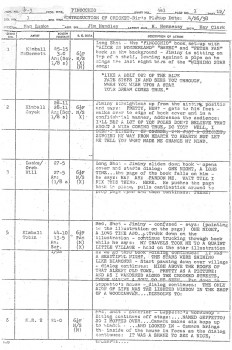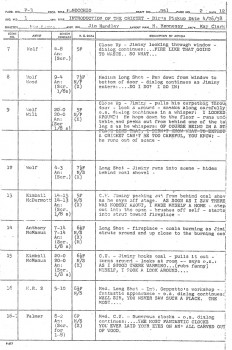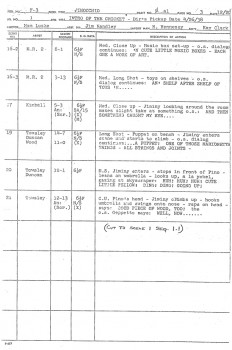Animation Artifacts 23 Feb 2006 07:50 am
Bookkeeping
I noticed one of these production forms on Blackwing Diaries, and thought someone out there might not have seen any of those for any of the features. So, I’m posting the first couple of pages from Pinocchio, Jiminy opening the movie.
(Click on the images to enlarge to a readable size.)
It fascinates me to see the detail in the production that Disney had organized. It gives a glimpse into the structure within that studio, at least during the old days. The most recent sheets I have like this are for Robin Hood. The information doesn’t seem quite as picayune on those pages, but I suspect it still was as organized.
The field guides indicated on these sheets are different than the field guides which we have today. Each field was indicated by 35mm not inches. Each field represented 35mm in height & width. Hence, it seems like they have all small fields indicated, but they’re not.
Today with computer animation, I’m not sure of the organization of the studios like Pixar or Dreamworks – or, for that matter, Disney. I suspect there has to be something similar, though I would expect it to be all computerized.




on 23 Feb 2006 at 8:46 am 1.Mark Mayerson said …
Thanks for these, Mike. These animator drafts are a wealth of information. While it’s known that Kimball was responsible for Jiminy, the number of other animators who did the character in the opening is a surprise to me.
I emailed Jenny Larew about the Nifty Nineties drafts she posted, but never got a reply. Sooner or later (I hope this year), I’m going to start a website or a blog devoted to animator credits. There’s a ton of knowledge out there in the hands of individuals (and I suspect that there are a lot of those Disney drafts out there as well), but nobody has pulled the information together.
I think that we owe it to the art form to document who did what. How can we understand our own history if we’re ignorant of whose work we’re looking at?
on 23 Feb 2006 at 9:11 am 2.Michael said …
Hi Mark, I always feel somewhat out of it here in NYC, and I don’t know how many people have these documents. I have Pinocchio through the Blue Fairy, and I’ll probably keep posting them a couple of pages each week. I find them fascinating. They really give me some kind of ethereal connection to the workings of the studio and the organization behind it all. It’s almost terrifying.
The forms for the Robin Hood sheets are the same, but they don’t feel as thought they have as much detail written into them.
On Carousel at the Hubley studio, John posted on big colored Oaktag sheets (each seq a different color) the same basic format. But his description of the scenes was down to a word or three, and in those few words captured exactly what the scene was about. He had a real gift for it.
on 23 Feb 2006 at 1:53 pm 3.Jenny Lerew said …
Wow–thank you, Michael!
I looked at these(never had a copy)back at the Disney Archives in ’81; Mark Mayerson says just what suprised me–I’d assumed Kimball would have done every good Jiminy scene. I was also suprised to see that in addition to Lampwick, Fred Moore did scenes with Gepetto(Gepetto?!)in Monstro.
-Good grief, Mark–I meant to reply–I didn’t? I was sure I had! Very late on my part, but not that long ago(10 days?) I’d be more than happy to help you out with your request–email me again, please!
on 23 Feb 2006 at 4:28 pm 4.Amid said …
Thanks Mike! You’ve given me a reason to watch Pinocchio again. And Mark, get that blog started! You’ve got great things to say.
on 24 Feb 2006 at 4:01 am 5.Didier Ghez said …
Michael: Thanks a million for posting those. They made my day. We need more of them, much more. Any serious Disney historian should venerate you for sharing this knowledge!
Mark: If you one day end up doing very complete research on Disney animators credits, I would love to publish the results in a special section of my Walt’s People book series.
Have a marvelous weekend.
Didier
on 25 Feb 2006 at 4:55 pm 6.Galen Fott said …
I’m curious to know if these drafts were created before or after the animation was done. I’m assuming the former is true, which in my mind leaves open the strong possibility that they aren’t 100% accurate. An animator gets assigned a scene in the draft, but he’s not finished on his last scene, or he calls in sick…and so someone else picks up the scene. But the draft isn’t corrected. And so we could be ascribing one animator’s traits and characteristics to another animator.
Don’t get me wrong, I think they’re fascinating and invaluable documents. But does anyone else think there’s a decent chance that they’re not entirely correct?
on 25 Feb 2006 at 5:01 pm 7.Michael said …
I believe they were corrected as the film progressed. If an animator left a scene and moved on, a secretary would keep the record straight and updated sheets would be sent to the appropriate people.
on 25 Feb 2006 at 10:07 pm 8.Hans Perk said …
From what I have seen so far, during production the number of the draft is indicated, like 1st or 2nd. When the production is finished, the Final draft would be made.
In 1978, I was shown around the studio by Ed Hansen, who lead me through a room with HUGE draft sheets hanging from the wall like a poster sales rack, with names of animators for The Fox & the Hound.
Still, some drafts (like Fantasia), have pages with the artist column empty. And I read somewhere that other drafts were changed because of politics (The writer noted the de-Natwickification of the Snow White draft by Ham Luske).
The drafts must have been produced and reproduced – the original Pinocchio draft from the BG Morgue is identical to the pages here, but clearly not typed at the same time…
Also, the supervising animator is normally not indicated. Like in Bambi on Ice (seq. 08.0 Fun in the snow), there are only 4 scenes credited to Frank Thomas, though he is known to have planned the seq., the rest is Phil Duncan and Bill Justice. (Frank’s scenes: C.U. Bambi smiles weakly at thumper, and Thumper unwinds Bambi until Bambi falls and scoops up Thumper).
The later drafts, like Robin Hood, have even short scenes with little dialogue spread out over two of the ten ‘lines’, and thus they fill twice as many sheets – each draft nearly an inch thick. Also, the EFX animators are not written in there, and normally the only info for BG is S(till) or P(an).
on 26 Feb 2006 at 12:58 am 9.Thad Komorowski said …
Mike,
This is GREAT stuff. Now I NEED to go watch Pinocchio soon. It’s a movie that should’ve been available on a high-quality DVD set since day one.
Mike (or anyone this could apply to), do you have drafts like this for Alice and Pan? If you do I’d be happy to pay you for xeroxes. Please let me know at : thadkomorowski@yahoo.com
on 26 Feb 2006 at 10:01 am 10.Hans Perk said …
As to Disney field sizes, figuring out how they measured up needed all the high school math I could muster – I prepared a little converter here: http://fields.afilm.net
on 26 Feb 2006 at 12:47 pm 11.Michael said …
The field guides were not just singular to the Disney studio. A layout I have from Fleischer shows the same proportions. I think it all changed after WWII when John Oxberry entered the picture and the Signal Corps, shut down. As I’d mentioned, I was told the earlier fields proportioned to units of 35mm, not inches.
on 26 Feb 2006 at 2:05 pm 12.Hans Perk said …
Very interesting to hear that the field sizes weren’t Disney only – I wonder who designed them first and when. The sizes on my converter page were based on many measurements on original layouts. How they convert to 35mm proportions (the camera aperture of 22 x 16 mm, or 0.866 by 0.630 inches would be very interesting to learn. The fact that the conversion is linear but not zero-based, unlike the later system, is a bit of a puzzle to me.
on 27 Feb 2006 at 12:36 pm 13.EBoles said …
It would be interesting to put these credits onto a subtitle track on the dvd, so as your watching, it tells you whose work you’re looking at.
Hans Perk mentions the removal of Natwick credits from Snow White. Another example may be Culhane’s lack of credit for Pinocchio. In his book Culhane is fairly adamant about what he animated, but I have been told that the draft sheets say differently. Possibly they were altered after these artists had left the studio, so that others could get bigger bonuses. This is just speculation.
on 02 Mar 2007 at 10:26 pm 14.Dante said …
Thank you so much for publishing these production forms, I haven’t seen these kind of document before. Is there anywhere online where more might be seen? What do some of the initals mean? Ive seen some of these on production drawings from the 30′s (such as a ‘P’ in the top right corner and an ‘x’ over the drawing number). What do these stand for? Does ‘B.G.Data’ refer to background data?
on 03 Mar 2007 at 8:17 am 15.Michael said …
Go to Hans Perk’s site A FILM LA to see more.